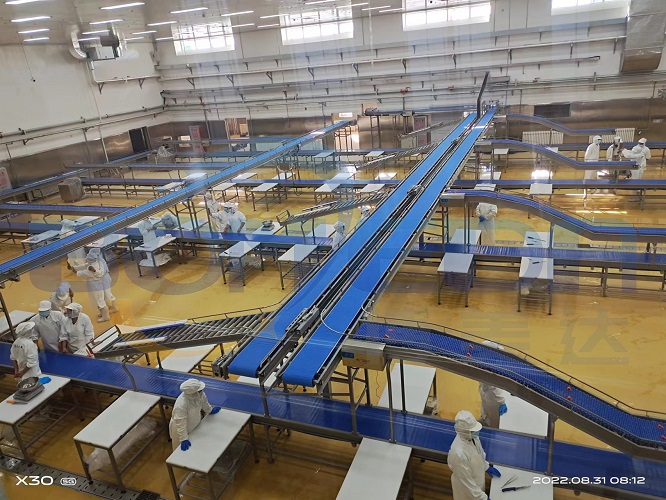1. Main products for shoulder blade area
1. Neck and back muscles (No. 1 meat)
The back of the neck muscles cut from between the fifth and sixth ribs;
2. Front leg muscle (No. 2 meat)
The front leg muscle cut from between the fifth and sixth ribs;
3. Meat front rib
Taken from the posterior and anterior parts of the 5th and 6th ribs of pigs, including the neck bone, small ribs, and No. 1 meat;
4. Front row
It is taken from the posterior and anterior joint part of the 5th and 6th ribs of the pig, and is cut along the sternum, the lower part of the ribs, together with the cervical and thoracic vertebrae, including the cervical bones, small ribs, sternum and intercostal muscles;
5. Short Ribs
Take it from the front chest rib area, with 5-6 ribs, remove the spine, inside and outside fat, remove the sternum, and keep the intercostal muscles intact.
6. Neck bone
Take it from the part before the fifth vertebra of the pig’s spine, remove the bones and saw off small ribs, the rib width is 1-2cm;
7. Bone-in pork elbow
First, cut from the wrist joint to remove the front hoof; then cut from the elbow joint to separate the front leg, leaving the skin, bones, and the inner and outer tendons of the front leg;
8. Others
Breast bone, front leg bone, cartilage edge, meat green, pig front extension, fan bone, etc.
2. Main products for back and ribs
1. Spareribs (Meat No. Ⅲ)
Cut the spine parallel to the ribs about 4-6 cm below the spine and remove the spine.
2. Spine
The subcutaneous fat tissue trimmed from the spine was cut parallel to the ribs about 4-6 cm below the spine.
3. Spine
Taken from the connection between the 5th and 6th thoracic vertebrae and the sacral vertebrae of the pig’s spine, the rib width is 4-6cm, remove the tenderloin, and keep an appropriate amount of lean meat.
4. Large steak
It is taken from the connection between the 5th and 6th thoracic vertebrae and the sacral vertebrae of the pig spine. The rib width is 4-6cm, with tenderloin under the spine.
5. Ribs
Taken from the abdominal rib area, with 8-9 ribs, trimmed of fat inside and outside, in a fan shape, with belly meat no more than 3cm.
6. Pork belly with skin
It is taken from the belly of the pig, with skin, spots on all sides, and the skin, meat and fat are not separated.
7. Belly ribs with skin
Taken from the abdominal ribs of pigs, with skin, rib bones and rib cartilage removed.
8. Ribs
Saw off the ribs 1-2 cm below the cervical vertebrae parallel to the spine. The ribs and ribs should be a whole piece without being separated. Remove the sternum.
9. Middle pork with bone
It refers to the meat with ribs after removing the front and back parts and the main chops, minus the breast.
10. Others
Spine with meat, whole ribs, belly ribs, prime ribs, ribs without belly, etc.
3. Main products of hind leg
1. Hind leg muscle (No. Ⅳ meat)
The muscles of the hind legs cut from the junction of the lumbar vertebrae and the lumbar sacral vertebrae (one and a half lumbar vertebrae are allowed);
2. Skin-on boneless hind leg
Debone the hind legs from the junction of the lumbar vertebrae and sacral vertebrae (one and a half lumbar vertebrae are allowed) and slightly trim the fat layer.
3. Coccyx
Take it from the lumbar sacral vertebra to the last coccyx, with an appropriate amount of interosseous meat.
4. Small pork trotter
Take the hind leg leg circle area (i.e. ankle joint area) sawed off about 2-3cm above the tarsal joint of the hind leg, with the skin intact or slightly longer to cover the leg bone, with tendons and meat.
5. Bone-jointed elbow
Cut off the hind hoof from the thinnest part of the leg bone (above the leg circle); then cut off the hind leg from the knee joint, leaving the skin, bone and the inner and outer tendons of the hind leg;
6. Others
Inner leg meat, outer leg meat, monk’s head, pig’s hind leg, rump meat, hind leg bone, fork bone, small bone joint, minced fat, minced meat, etc.
The above segmentation can use our segmentation conveyor line to clarify the segmentation process and improve segmentation efficiency.
Post time: May-04-2024

